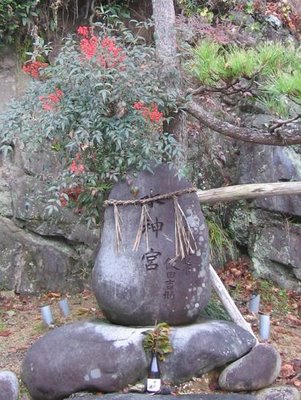. Interior Design - The Japanese Home .
::::::::::::::::::::::::::::::::::::::::::::::::::::::::::::::::::::::::::::::::::::::::::::::::::::::::::::::::::::::::::::::::::::::::::::::::::::::::::::::::::::::::::::::::::::
sentaku 洗濯 washing, doing the laundry in Edo
In rural Japan, washing was often done at a river side. Some villages also had a special small waterway run through the main street and homes could use this water.
Remote homes all had a special well or wakimizu 湧き水, fresh water welling out from the mountains and kept in a container, to be used for drinking, washing, bathing etc.
In towns, wells were the place to get water and cleaning the wells was important.
. sarashi-i . 晒井 cleaning the well .
kigo for early summer
and
idohori shi 井戸堀師 craftsman digging a well or making a new well

The Water Deity of Katsuyama, Okayama
The goodwill of the God of Water is very important to a rice-growing and farming society.
. Suijin sama 水神様 The God of Water .
Mizu no Kamisama 水の神様 / Sui-ten Suiten 水天
Doing the laundry for a big family in the Edo period . . . without electricity, was hard work.

Water was placed in a bucket and the cloth was rubbed on
sentakuita, sentaku-ita 洗濯板 a wooden board.
Natural soap consisted of wood ash and fat or some alkali substance.
..............................................................................................................................................

source : Tokyo Metropolitan Library
洗い張り arai-hari by 歌川国安 Utagawa Kuniyasu (1794 - 1832)
A kimono was usually taken apart and the pieces washed and later sowed together again:
arai-hari, araihari, arai hari 洗い張り / 洗張り wash and stretch
tokiarai, toki-arai 解き洗い / 解洗い take apart and wash
This form of washing was used for Kimono and haori 羽織 jackets.

- quote -
In the past, a kimono would often be entirely taken apart for washing, and then re-sewn for wearing. This traditional washing method is called arai hari. Because the stitches must be taken out for washing, traditional kimono need to be hand sewn.
After washing, he fabric is stretched on a delicate frame of bamboo and strings or pasted on a wooden board.
Arai hari is very expensive and difficult and is one of the causes of the declining popularity of kimono.
Modern fabrics and cleaning methods have been developed that eliminate this need, although the traditional washing of kimono is still practiced, especially for high-end garments.
- - - More in the WIKIPEDIA !

source : lb.nagasaki-u.ac.jp/siryo-search
arai-hari in the Meiji period
The wooden plates were covered with nori 糊 natural glue and the pieces stretched on them.
The plates were made of sugi 杉 one piece of cedar wood.
The glue was funori 布海苔 made from sea weed (red algae, Gloiopeltis frucata.
Drying the robes on bamboo poles or placing the parts of a kimono on wooden boards -
this gave reason to a special business in Edo:
. hari-ita uri 張り板売り vendors of wooden boards to dry a kimono after washing .
. kimono 着物 traditional Japanese robe .
- reference : arai hari -
::::::::::::::::::::::::::::::::::::::::::::::::::::::::::::::::::::::::::::::::::::::::::::::::::::::::::::::::::::::::::::::::::::::::::::::::::::::::::::::::::::::::::::::::::::
. idobata kaigi 井戸端会議 debates (gossip) at the well .
Women used to come to the village wells and designated places along rivers to do the laundry
and the mental laundry (gossip)。
..............................................................................................................................................
. oni no inu ma ni sentaku 鬼の居ぬ間に洗濯 .
Doing the laundry while the devil is away.
the mice enjoy the home while the cat is away
::::::::::::::::::::::::::::::::::::::::::::::::::::::::::::::::::::::::::::::::::::::::::::::::::::::::::::::::::::::::::::::::::::::::::::::::::::::::::::::::::::::::::::::::::::
. Legends and Tales from Japan 伝説 - Introduction .
................................................................................. Shizuoka 静岡県
浜松市 Hamamatsu
sentakugitsune, sentaku kitsune 洗濯狐 the Fox doing laundry
Near the river 平釜川 Hiragama thre was a temple with many trees in the compound. At night, a fox came to the river and people could hear the sound of ザブザブ zabu zabu as if he was doing the laundry.

CLICK for more photos !
. kitsune densetsu 狐 伝説 fox legends - Introduction .
..............................................................................................................................................
- reference : nichibun yokai database -
洗濯 68 to explore / 14 洗濯物
洗濯狐 - ok
::::::::::::::::::::::::::::::::::::::::::::::::::::::::::::::::::::::::::::::::::::::::::::::::::::::::::::::::::::::::::::::::::::::::::::::::::::::::::::::::::::::::::::::::::::
- - - - - H A I K U and S E N R Y U - - - - -
. Kobayashi Issa 小林一茶 in Edo .
洗たくの婆々へ柳の夕なびき
sentaku no baba e yanagi no yuu nabiki
to the old woman
doing laundry, the evening
willow bows
Tr. David Lanoue

source : lotusgreenfotos.blogspot.jp - Doris Boulton
. WKD : yanagi 柳 willow .
- - kigo for late spring - -
::::::::::::::::::::::::::::::::::::::::::::::::::::::::::::::::::::::::::::::::::::::::::::::::::::::::::::::::::::::::::::::::::::::::::::::::::::::::::::::::::::::::::::::::::::

- - - To join me on facebook, click the image !
:::::::::::::::::::::::::::::::::::::::::::::::::::::::::::::::::::::::::::::::::::::::::::::::::::::::::::::::::::::::::::::::::::::::::::::::::::::::::::::::::::::::::::::::::::::
. Edo bakufu 江戸幕府 The Edo Government .
. Famous Places and Powerspots of Edo 江戸の名所 .
. Doing Business in Edo - 商売 - Introduction .
. shokunin 職人 craftsman, craftsmen, artisan, Handwerker .
. senryu, senryū 川柳 Senryu poems in Edo .
. Japanese Architecture - Interior Design - The Japanese Home .
. Legends and Tales from Japan 伝説 - Introduction .
[ . BACK to DARUMA MUSEUM TOP . ]
[ . BACK to WORLDKIGO . TOP . ]- - - - - #sentakuwashing #washingsentaku - - - -
::::::::::::::::::::::::::::::::::::::::::::::::::::::::::::::::::::::::::::::::::::::::::::::::::::::::::::::::::::::::::::::::::::::::::::::::::::::::::::::::::::::::::::::::::::
1 comment:
Legend from Tokushima 徳島県
.
The last day 20 of the year hatsuka 二十日 in December in the local dialect is called
hatsuru hatsuka 果つる二十日
On this day many bad things can happen and people refrain from going very far, doing a great house-cleaning, having a wedding ceremony or do sentaku 洗濯 a lot of washing.
.
https://heianperiodjapan.blogspot.com/2020/03/hatsuka-day-20-legends.html
.
Post a Comment